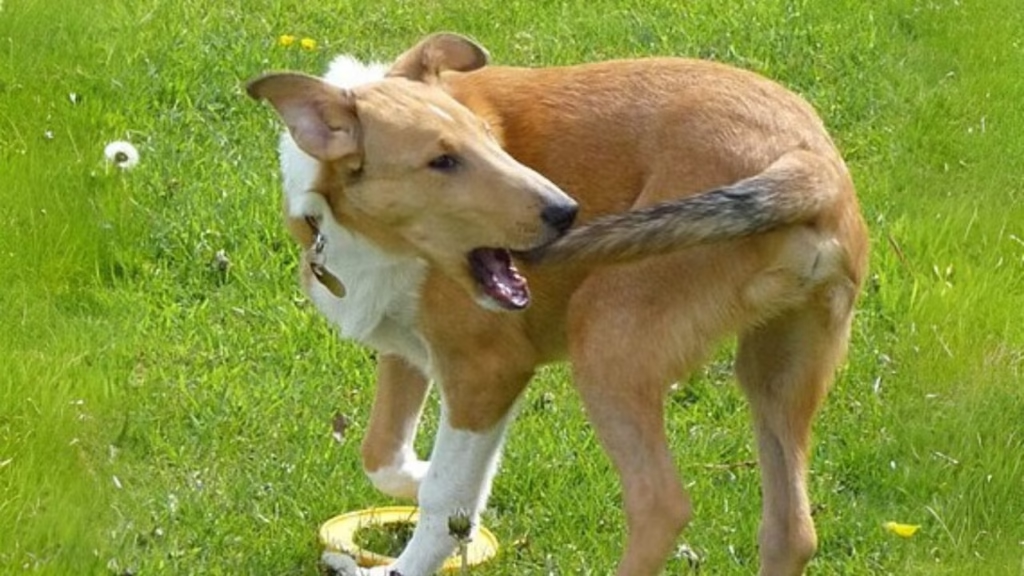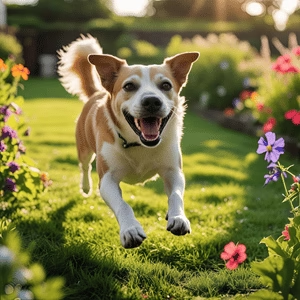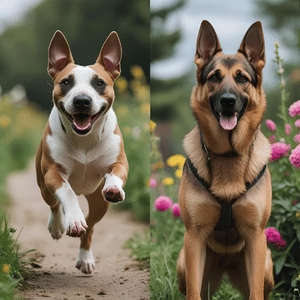You know that moment when you’re watching your dog spin in circles like a furry tornado, and you can’t help but wonder what’s going through their head?
Yeah, we’ve all been there.
Well, think about it. Your adorable rescue pup is chasing their tail like it’s the most fascinating thing in the world, and you’re standing there wondering if this is normal or if you should be calling the vet.
Pretty confusing, right?
However, there’s a question that hovers around it: “Is my dog’s tail chasing something to worry about?”
Some think, “It’s just cute puppy behavior!”
Others believe, “This definitely means something’s wrong.”
And then there are the new pet parents, looking for real answers, practical guidance, actual peace of mind.
And guess what? There are stories of tail chasing being completely harmless fun, and others where it signals something that needs immediate attention.
But how? Why?
We’re about to unravel the mystery.
Can Tail Chasing Actually Be Normal?
Yes, absolutely.
Here’s the deal.
Dog tail chasing is like that friend who sometimes makes perfect sense and other times leaves you completely baffled.
Most of the time? It’s totally harmless.
Think playful puppies discovering their bodies, bored dogs looking for entertainment, or attention-seeking pups who’ve figured out that spinning gets them noticed.
To simplify, it’s like a dog’s version of fidgeting.
There’s no “one-size-fits-all” answer here. But if your dog occasionally chases their tail, seems happy, and can be easily distracted? You’re probably in the clear.
But remember, while most tail chasing is innocent, some cases need attention. Research shows that tail chasing can become problematic when it’s frequent, compulsive, or leads to injury.
As for those concerning stories I mentioned?
They’re not meant to scare you. From compulsive disorders to medical issues, there are real reasons some dogs can’t stop the spinning.
But, and this is a big but, knowing the difference is key. Always.
REAL TALK: Understanding why dogs chase their tail isn’t about becoming a canine psychologist. It’s about knowing when to laugh and when to pick up the phone to call your vet. I break down the signs, but you make the call that’s right for your furry friend.
The 7 Main Reasons Behind the Spin
Alright, folks! Time for some tail-chasing truth:
1. Pure Playfulness and Exploration
What’s happening?
Your dog discovered they have this amazing moving toy attached to their body, and it’s the best thing ever.
Who does this?
Mostly puppies who are still figuring out their bodies. It’s like watching a toddler discover their toes – pure curiosity and entertainment.
The science bit:
Young dogs engage in tail chasing as part of normal play behavior. Their tail moves, catches their eye, and suddenly they’re in hot pursuit of this fascinating moving target.
Should you worry?
Nope! This is completely normal developmental behavior that most dogs grow out of as they mature and find other forms of entertainment.
What to do?
Enjoy the show, maybe grab your phone for a cute video. Just don’t make a huge fuss that might reinforce the behavior if it becomes excessive.
2. Boredom and Energy Overload
The situation:
Your dog has been cooped up all day and needs to burn off some steam.
The reality:
Dog tail chasing often happens when dogs don’t get enough physical or mental stimulation. It’s their way of creating their own entertainment when the world feels boring.
The research:
Studies show that insufficient physical activity and mental stimulation can result in various behavioral problems, including tail chasing. Dogs may resort to chasing their own body parts as a way to release pent-up energy without external input.
The signs:
- Happens more when your dog has been inactive
- Often occurs indoors during quiet periods
- Dog seems restless or hyperactive
- Easily redirected to other activities
The fix:
More walks, puzzle toys, interactive play sessions. Think of it as giving your dog a job to do instead of letting them create their own entertainment.
3. “Hey, Look at Me!” Behavior
Here’s what happened:
Your dog chased their tail once, you laughed, and now they think they’ve discovered the secret to getting your attention.
The psychology:
Dogs are incredibly smart. They learn what gets them noticed – and here’s the kicker – even negative attention counts as attention.
The reinforcement cycle:
Every time you react to tail chasing (laughing, saying “no,” or even just looking), you’re potentially reinforcing the behavior. Your dog thinks, “Aha! This works!”
The tricky part:
Even scolding can reinforce attention-seeking tail chasing because it’s still interaction and focus from you.
The solution:
Ignore the spinning, reward calm behavior instead. Train alternative attention-getting behaviors like sitting politely or bringing you a toy.
4. Medical Issues and Discomfort
When it’s serious:
Sometimes tail chasing means your dog is genuinely uncomfortable and trying to address a physical problem.
Common medical culprits:
- Intestinal parasites: Especially tapeworms that migrate out of the rectum, causing irritation
- Flea infestations: Creating itching and discomfort around the tail area
- Anal gland problems: Impacted or infected anal glands can cause significant discomfort
- Tail injuries: From being caught in doors, stepped on, or other trauma
- Neurological issues: Problems affecting sensation or motor control in the tail area
- Skin conditions: Dermatitis, allergies, or infections causing itching
The warning signs:
- Sudden onset of tail chasing in an adult dog
- Obsessive focus on the tail area
- Signs of pain or distress
- Visible irritation, wounds, or hair loss on the tail
- Difficulty being distracted from the behavior
Your move:
If the chasing seems medical in nature, vet time. Don’t wait if you see physical signs of irritation or if the behavior started suddenly.
5. Breed Tendencies and Genetics
The genetics factor:
Some breeds are just more prone to this behavior, suggesting there’s a hereditary component.
The usual suspects:
Research consistently shows higher rates of tail chasing in:
- Bull Terriers: Studies suggest the disorder may be transmitted via recessive genes
- German Shepherds: Frequently mentioned in tail-chasing research
- Anatolian Sheepdogs: Also show genetic predisposition
- Staffordshire Bull Terriers: Another breed with higher incidence
Interesting facts:
- Males are more likely to develop tail-chasing behavior than females
- Genetic predisposition doesn’t guarantee the behavior will develop
- Environmental factors play a crucial role in whether genetically susceptible dogs actually start tail chasing
What this means for you:
If you’re adopting one of these breeds, be aware of the potential but don’t panic. With proper exercise, mental stimulation, and attention to triggers, many genetically predisposed dogs never develop problematic tail chasing.
6. Stress, Anxiety, and Emotional Triggers
The emotional component:
About 30% of owners report that stressful or frustrating situations trigger tail chasing in their dogs.
Common stress triggers:
- Meeting new people or animals
- Anticipating scary events (like vet visits)
- Changes in routine or environment
- Loud noises or chaotic situations
- Separation anxiety when left alone
- Social conflict with other pets
The coping mechanism:
Some dogs spin to self-soothe, similar to how humans might bite their nails or fidget when nervous. It’s a way to redirect anxious energy into a repetitive, somewhat comforting behavior.
The escalation risk:
Stress-induced tail chasing can become a learned coping mechanism that gets triggered more and more easily over time if not addressed.
Management strategies:
- Identify and minimize stress triggers when possible
- Teach alternative coping behaviors
- Consider anxiety management techniques
- In severe cases, anti-anxiety medication might be helpful
7. Compulsive Disorder – When It Gets Serious
When it becomes obsessive:
In some cases, tail chasing develops into a compulsive disorder similar to obsessive-compulsive disorder (OCD) in humans.
The clinical picture:
Dogs with compulsive tail chasing may:
- Chase their tails multiple times per day
- Seem unable to stop even when called or distracted
- Continue until they injure themselves
- Show other repetitive behaviors like spinning, pacing, or excessive licking
- Become aggressive when interrupted
The concerning statistics:
Research indicates that dogs who appear difficult to distract during tail-chasing episodes may be showing signs of compulsive behavior that requires professional intervention.
The serious consequences:
Compulsive tail chasing can lead to:
- Severe injuries including fractures from running into objects
- Skin abrasions and infections from repeated trauma
- Hair loss and open wounds on the tail
- In extreme cases, tail amputation or even euthanasia if other treatments fail
Treatment options:
- Behavioral modification therapy
- Environmental management
- Medication targeting serotonin or dopamine levels
- Professional intervention from veterinary behaviorists
When Should You Actually Worry?
Here’s your “call the vet” checklist:
Frequency red flags:
- Multiple episodes per day
- Behavior lasting more than a few minutes at a time
- Happening for more than a week consistently
Intensity concerns:
- Can’t be easily distracted or interrupted
- Dog seems “stuck” in the behavior
- Appears distressed or frantic while chasing
Physical warning signs:
- Causing injury, hair loss, or wounds
- Visible irritation around the tail area
- Limping or signs of pain
Behavioral disruptions:
- Interfering with eating, sleeping, or normal activities
- Dog becomes aggressive when you try to interrupt
- Other compulsive behaviors developing alongside tail chasing
Sudden changes:
- Starting suddenly in an older dog who never did this before
- Dramatic increase in frequency or intensity
- Associated with other concerning symptoms
What You Can Actually Do – The Action Plan
Immediate Intervention Strategies
Step 1: Don’t panic (most cases are harmless)
Step 2: Try the “incompatible behavior” approach:
- Teach a solid “down” command – can’t chase your tail while lying down
- Use “sit” or “stay” commands when you see the behavior starting
- Redirect to activities that require focus, like “find the treat” games
Step 3: Timing is everything:
- Interrupt before the behavior becomes a full episode
- Redirect when you see the “pre-spinning” signs
- Don’t wait until your dog is already in full chase mode
The distraction method:
Research shows that early intervention with simple commands and redirection can be highly effective. The key is consistency and timing.
Long-term Management Strategy
Exercise more:
Many cases are just boredom in disguise. Increase:
- Daily walk duration and frequency
- High-energy play sessions
- Activities that tire both body and mind
Mental stimulation revolution:
- Puzzle toys that challenge problem-solving skills
- Training sessions that engage their brain
- Interactive games like hide-and-seek
- Food-dispensing toys that make meals more engaging
Environmental enrichment:
Create a more stimulating environment with:
- Rotating toys to maintain novelty
- Safe exploration opportunities
- Social interaction with other dogs (if appropriate)
- Varied walking routes and experiences
Ignore attention-seeking:
If the behavior is for attention:
- Don’t accidentally reward the behavior with reactions
- Teach alternative ways for your dog to get attention
- Reward calm, appropriate behavior instead
Professional help when needed:
If behavior persists more than a week, gets worse, or shows signs of compulsion, consult:
- Your veterinarian for medical evaluation
- A certified dog behaviorist for behavior modification
- Consider medication for severe cases
Special Considerations for Rescue and Shelter Dogs
The shelter factor:
Many shelter dogs develop behavioral quirks, including tail chasing, due to:
- Stress from the shelter environment
- Boredom from limited stimulation
- Anxiety from uncertain circumstances
- Lack of adequate exercise and mental enrichment
The good news:
This doesn’t mean they’re “broken” or permanently damaged. Most shelter-related behavioral issues, including tail chasing, often resolve with:
- Patience and understanding from new owners
- Consistent routine and structure
- Adequate physical exercise and mental stimulation
- Time to decompress and feel secure
The transition period:
Many problematic behaviors disappear once dogs are in stable, enriching homes with:
- Regular exercise schedules
- Consistent human attention and interaction
- Mental challenges and environmental enrichment
- A sense of security and belonging
What to expect:
Give your newly adopted dog at least 3-6 months to fully adjust. Many behaviors that seem concerning initially may naturally resolve as your dog settles into their new life.
The Bottom Line on Tail Chasing
Understanding why dogs chase their tail isn’t rocket science, but it is important.
Most of the time? It’s harmless fun that’ll make you smile.
Sometimes? It’s a sign your dog needs more exercise, mental stimulation, or attention to their environment.
Rarely? It indicates a medical or behavioral issue that needs professional attention.
The key is knowing the difference, trusting your instincts, and not hesitating to consult your vet when something feels off.
Remember, you’re not trying to eliminate all tail chasing – you’re just making sure it stays in the “cute and harmless” category rather than becoming a problem that affects your dog’s quality of life.
With proper attention, exercise, and care, most dogs can enjoy the occasional tail chase without it becoming a concern. And honestly? Sometimes it’s just dogs being wonderfully, weirdly dogs.
Quick FAQ Round
Q: Is puppy tail chasing different from adult dog tail chasing?
A: Absolutely. Puppies do it more as exploration and play – totally normal developmental behavior. Adults usually have specific reasons like boredom, attention-seeking, or medical issues.
Q: Should I laugh when my dog spins?
A: Enjoy it, but don’t make a big fuss if you suspect it’s attention-seeking behavior. Laughing can accidentally reinforce the behavior if your dog is doing it for attention.
Q: How much is too much?
A: Multiple times daily, can’t be interrupted easily, or lasting more than a week consistently = vet consultation time. Trust your gut if it feels excessive.
Q: Can it cause injury?
A: Yes – excessive chasing can lead to hair loss, skin problems, infections, and even fractures from running into things while spinning.
Q: Are some breeds really more prone to this?
A: Yep, genetics play a real role. Bull Terriers and German Shepherds show significantly higher rates, suggesting hereditary factors.
Oh, And One Last Thing:
If your dog starts chasing their tail while simultaneously solving complex math problems, you might want to check if you’ve accidentally adopted a genius… or if you need more coffee.
Chuckles aside, tail chasing is usually just dogs being dogs. Trust your gut, enjoy the silly moments, and remember – when in doubt, your vet is your best resource for peace of mind.
With love and minimal spinning,
Jeremy Lennox
Founder, Whisker Wellness






